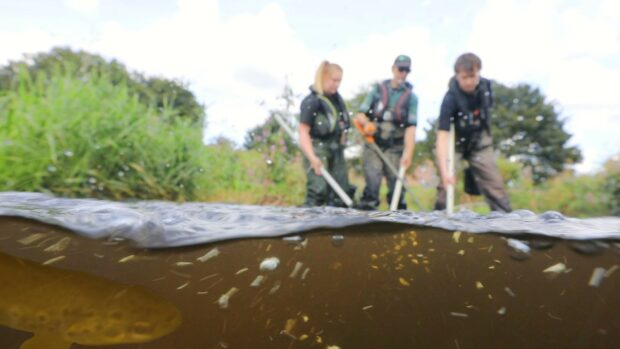
10 years ago, the Environment Agency started work to restore salmon and sea trout to the River Derwent. Today, they are flourishing along the river’s full twenty-mile stretch. This has been achieved in a body of water that was almost devoid of fish in the middle of the last century due to industrialisation.
The problems for the River Derwent’s fish began at the dawn of the industrial revolution, some 300 years ago. A dam prevented their return from the sea to spawn upstream. Later, steel and coke works – as well as other industry – would pollute the river. By the 1950s and 1960s, there were virtually no fish in the watercourse.
Work to correct that began in earnest in 2013, with the completion of a first major fish pass which meant, for the first time in three centuries, salmon and sea trout could spawn.
In this blog, we’ll take you upstream, past a decade of projects to recover the River Derwent.
Derwenthaugh Weir (2013)
Just a short distance up from the Derwent’s confluence with the River Tyne is Derwenthaugh Weir. It’s a significant structure and the first major obstruction for salmon and sea trout. A fish pass was built here in partnership with Gateshead Council.
The project was a challenge. Due to the site’s industrial legacy, the ground under the weir was contaminated. Real care had to be taken not to release that contamination to the river.
Once completed in 2013, it meant the first barrier to the fishes’ spawning migration had been passed.
Lintzford Weir (2016)
The next significant block for our salmon and sea trout is Lintzford Weir. Finishing the fish pass here in 2016 opened up a further 11km of spawning ground.
This pass was very carefully designed to mimic the natural cascade of the river using boulders to make ‘steps’ for the fish to gradually work their way to the top of the weir.
The Environment Agency undertook a lot of partnership work here, exploring how to improve the natural heritage of the Derwent Valley while preserving its industrial history.
Shotley Bridge Weir (2019)
300-years old, Shotley Bridge weir historically provided water for a paper mill. The fish pass here not only aids migratory fish but helps resident species like trout and grayling to move freely up and down the river.
Here, the Environment Agency worked with partners including the Tyne Rivers Trust and the Marine Management Organisation to build a rock pool fish pass. It’s essentially six pools that get gradually deeper, allowing fish to swim through and get higher up past the weir. There’s also a side channel to give fish another option during high flows.
2023 and Beyond
At the top of the River Derwent catchment, near Derwent Reservoir, we reach the end of the salmon and sea trout’s spawning migration journey! The fish are present along more than 20 miles of the main River Derwent, all the way back to the confluence with the Tyne. It’s all the more impressive given it was achieved without artificial stocking.
Going forward, the Environment Agency and its partners are looking at opening up some of the major tributaries of the River Derwent to salmon and sea trout, such as the Burnhope Burn.
You can watch a video about the recovery of the River Derwent on Youtube.
Follow the Environment Agency Yorkshire and North East on X (formerly Twitter).

5 comments
Comment by Dave Wilkinson posted on
Restoration applied to a river which we all know up here suffers from totally- inadequate compensation flows from Derwent Reservoir - ? A reservoir built at a time of ignorance for the supply of potted water to North East residents. Like the Kielder Scheme, another White Elephant.
Comment by Allan Sherrington posted on
Looking at it another way, these reservoirs have capacity to compensate river flows in times of drought, and with changes to our weather patterns taking place, who knows what the future brings.
Comment by Dave Wilkinson posted on
You make an excellent point and this might be our future but at the cost of depleting a natural resource of course. Hence the massive protests at the instigation of the Kielder Scheme.
Derwent was commissioned when we peasants * doffed out caps to those in power and is a disaster. Thank you.
* likely the same councillors who ruined the River Coquet in the 1950’s, a leading English Salmon river at the time and with an unlimited abstraction licence at that time.
Comment by David Ranson posted on
I don't agree. If correct how is the Tyne the top Salmon and Sea Trout in England and Wales. Salmon are netted at Kielder, stripped of their eggs then raised in tanks to be released back into the Tyne.
This is no White Elephant.
Comment by Dave Wilkinson posted on
Then for those who don’t agree:
The input of hatchery eggs into the Tyne catchment is dwarfed by the deposition from the “ hybrid “ stock running “ naturally into the river. With the current rod catch these last few years of c 2000 salmon, an exploitation rate of 20% and a female ratio of 60% and assumed average 10lb female depositing 5,000 eggs gives 30million eggs. The hatchery has reverted to stocking fry ( Fed I assume in autumn ) since at least 2018, hatchery capacity is only c 600,000 eggs. QED. Thanks Dave